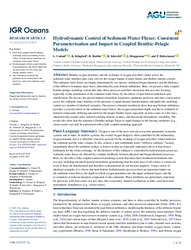AbstractBenthic oxygen dynamics and the exchange of oxygen and other solutes across the sediment‐water interface play a key role for the oxygen budget of many limnic and shallow marine systems. The sediment‐water fluxes are largely determined by two factors: sediment biogeochemistry and the thickness of the diffusive boundary layer that is determined by near‐bottom turbulence. Here, we present a fully coupled benthic‐pelagic modeling system that takes these processes and their interaction into account, focusing especially on the modulation of the sediment‐water fluxes by the effects of near‐bottom turbulence and stratification. We discuss the special numerical methods required to guarantee positivity and mass conservation across the sediment‐water interface in the presence of rapid element transformation, and apply this modeling system to a number of idealized scenarios. Our process‐oriented simulations show that near‐bottom turbulence provides a crucial control on the sediment‐water fluxes, the oxygen penetration depth, and the re‐oxidation of reduced compounds diffusing upward from the deeper benthic layers especially on time scales of a few days, characterizing oceanic tides, internal seiching motions in lakes, and mesoscale atmospheric variability. Our results also show that the response of benthic‐pelagic fluxes to rapid changes in the forcing conditions (e.g., storm events) can only be understood with a fully coupled modeling approach.
Plain Language Summary: Oxygen is one of the most relevant ecosystem parameters in marine systems and in lakes. In shallow systems, the overall oxygen budget is often controlled by the sedimentary oxygen demand, and it is therefore crucial to account for the exchange of oxygen and other solutes between the sediment and the water column. In this, context, a thin (millimeter‐scale) “diffusive sublayer,” located immediately above the sediment surface, is known to play an especially important role as it may form a bottleneck for the solute exchange. As the thickness of this sublayer is controlled by hydrodynamic processes, sediment‐water fluxes are affected by complex feedbacks between physical and biogeochemical processes. Here, we describe a fully coupled numerical modeling system that takes these feedback mechanisms into account, including advanced numerical methods guaranteeing that the total mass of all solutes is conserved (even if these are transformed) and that their concentrations do not become negative. Using a series of idealized examples, it is shown that near‐bottom hydrodynamic processes have an important impact on the sediment‐water fluxes, the depth to which oxygen penetrates into the upper sediment layers, and the re‐oxidation of reduced chemical compounds in the sediments. These feedbacks are particularly important for processes with time scales of a few days, like ocean tides, internal oscillations in lakes, and short‐term atmospheric disturbances (e.g., storm events).
Key Points: First fully coupled benthic‐pelagic modeling system accounting for the effects of near‐bottom turbulence on sediment‐water solute fluxes. Hydrodynamic effects control benthic biogeochemistry and fluxes especially on time scales of a few days, and during extreme events. New numerical methods that guarantee mass conservation and positivity across the sediment‐water interface.
This is an open access article under the terms of the Creative Commons Attribution‐NonCommercial‐NoDerivs License, which permits use and distribution in any medium, provided the original work is properly cited, the use is non‐commercial and no modifications or adaptations are made.


